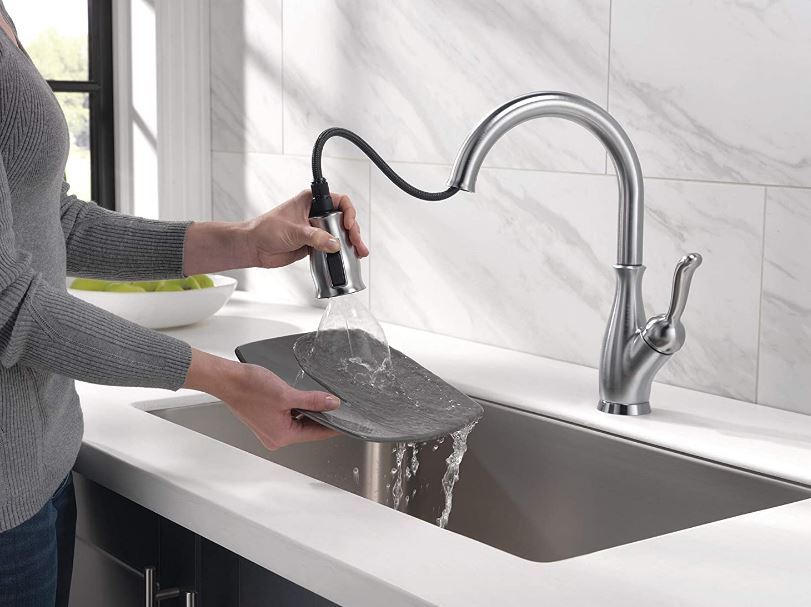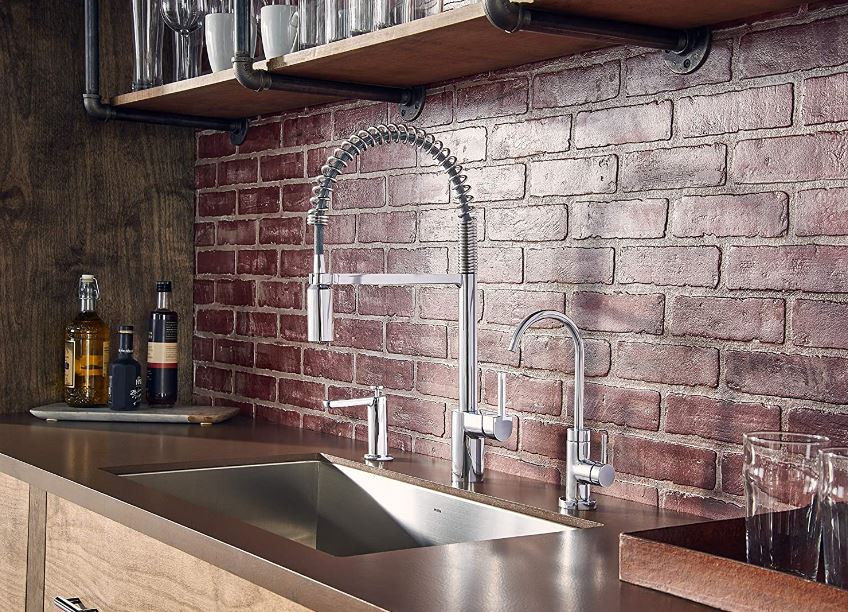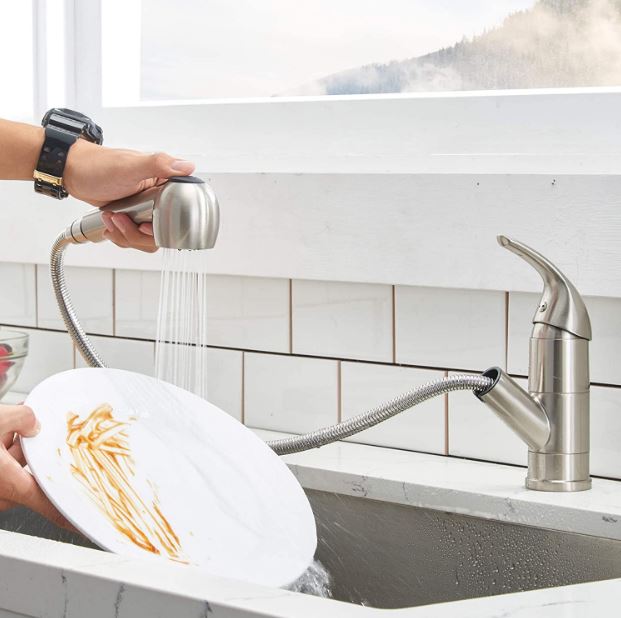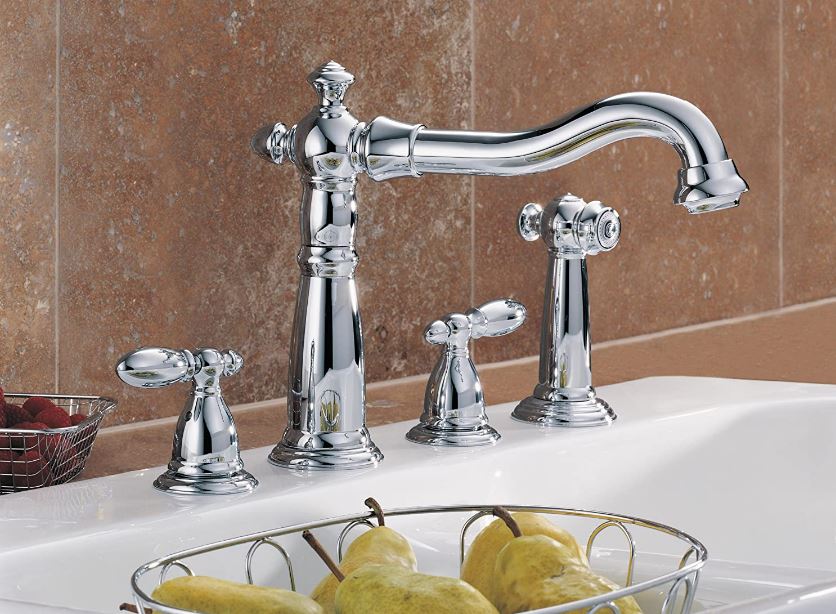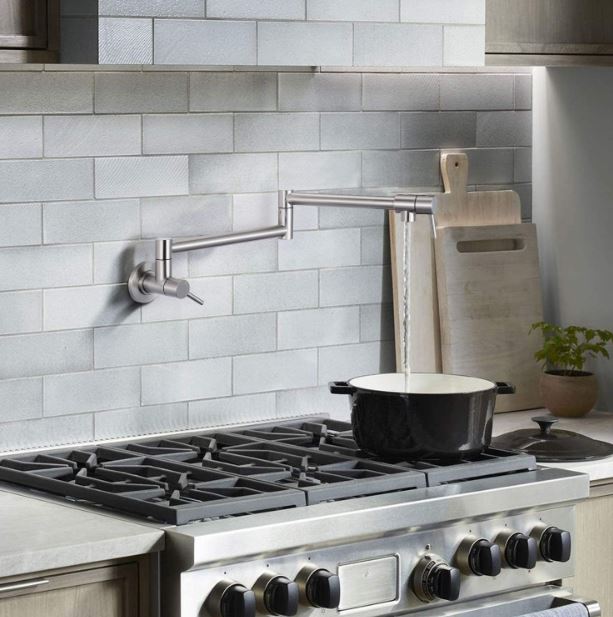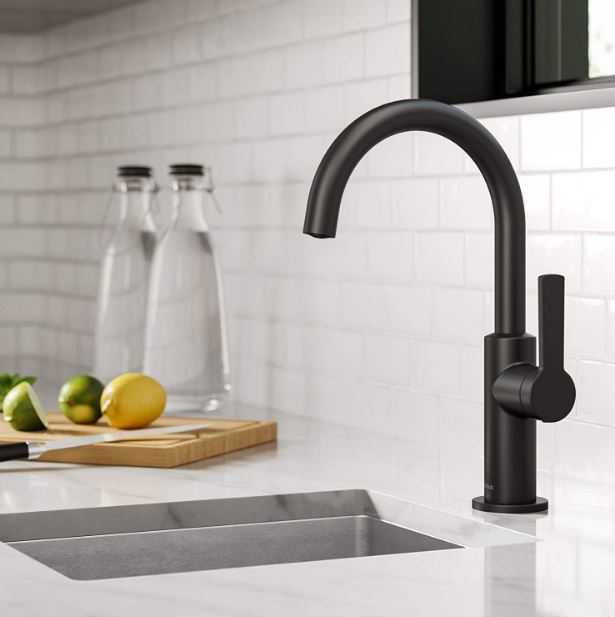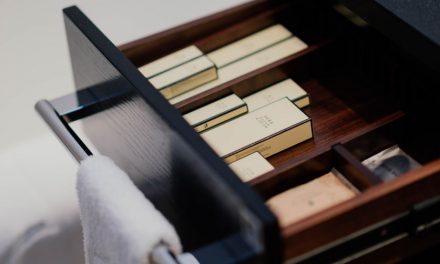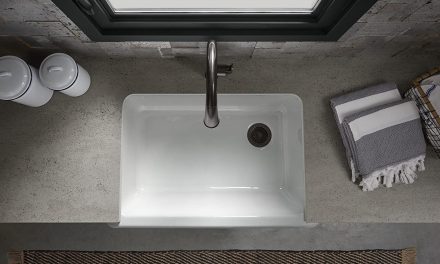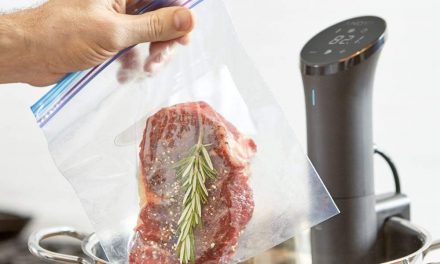Is there anything used more in the kitchen than the faucet? Between washing hands and dishes, and filling pots and glasses, we use the kitchen faucet for a whole lot. It’s especially important, then, to have a good one.
In this article we’ll talk about the common types of kitchen faucets. We’ll break down different finishes and what you’ll need (and need to know) before having one installed. We even have some quick suggestions if you’re looking to DIY.
But the biggest difference between kitchen faucets is the style.
Types of kitchen faucets
Gone are the days when your only option was a single, simple tap with a handle or two. Today, faucets are available in a variety of styles to fit every need and every sink. From traditional styles to app-connected smart faucets, there’s a style that’s perfect for you and your kitchen.
Pull-down faucets
A pull-down faucet features a high-arching gooseneck shape. The heads of these faucets are attached to a retractable hose that allows you to maneuver the spray into tight corners. This is great for hand washing pots and pans in large sinks since you can direct the spray exactly where you want it.
Some pull-down faucets are also pre-rinse faucets. A pre-rinse faucet features the same high-arching design but also generally has an exposed hose held in place by a steel helix (think slinky partially pulled open). Originating in commercial kitchens, these faucets are very useful for filling tall pots, but do require high water pressure to operate. Their industrial look may be out of place in some sinks, but they can add a professional touch to a home kitchen.
Pros
- Great for large sinks
- Especially useful for handwashing pots and pans
Cons
- Not good for shallow sinks
- Unsuited for lower water pressures
Price range: $40+ but varying widely depending on style and quality. Pre-rinse faucets start at $80, with most models being around $150. Installation costs for most faucets average around $150.
Pull-out faucets
A pull-out faucet is similar to a pull-down faucet in that the faucet head features a retractable hose. However, unlike with pull-down faucets, these faucet heads have a much wider range of motion and a much longer hose. This allows you to not only reach every corner of your sink, but far beyond. Fill pots that are sitting on countertops, spritz down salad greens sitting in a colander, and more!
Pros
- Good for smaller sinks
- Have more control over the direction of the spray
Cons
- It can be easy to splash counters and floors
- May not be appropriate in houses with younger children
Price range: $50+, though these faucets top out at much lower prices than pull-down faucets. Higher-end pull-out faucets retail for around $250. Installation costs are still likely to be around $150 with this style.
Side-spray faucets
A side spray faucet has a simpler faucet head than a pull-down or pull-out faucet. Instead of having a sprayer integrated into the main faucet, this style has a separate sprayer that sits to the side. Much like pull-out faucets, a side-spray sprayer can be pulled into different directions and can reach both sink and countertop. This is a traditional style of faucet that exists in many older homes, but side spray faucets also fit well into the newest kitchens.
Pros
- If the sprayer breaks, you can still use the sink
Cons
- Sprayer may not reach all of the sink, depending on hose length
- Sprayer may not be as high pressure as integrated sprayers
- Separate sprayer requires its own faucet hole
Price range: $40+ with sprayer included, though these faucets vary widely in price. Installation costs may be slightly higher due to the separate sprayer, but these faucets are still fairly easy to install.
Low-touch and touchless faucets
Low-touch and touchless faucets are some of the newer faucets on the market. They’re more common in public restrooms, but they’re gaining popularity in home kitchens. Instead of a handle that turns the water on, these sinks have sensors. For low-touch and touch-on faucets, the sensor is tapped to turn the water on and off, minimizing the amount of contact needed. Some low-touch faucets even have foot-operated sensors. For touchless faucets, simply placing your hand (or a pot) in front of the sensor is enough to turn the water on.
Most of these faucets have handles for temperature control and may have displays (with or without color indicators) of the current temperature.
Pros
- Simplifies cleaning
- Hands free (or low-touch) operation is great for the busy cook
Cons
- Complicated to fix
- Motion and touch sensing might be finicky
- If battery powered, batteries will have to be replaced
- If powered by wall outlet, sink may not function at all if power is out
Price range: Low-touch and touchless faucets start at around $100, and this is one style of faucet where you’re more likely to get what you pay for. Expect to pay $250-$400 for a high quality low-touch or touchless faucet, not including installation costs.
Smart faucets
Smart faucets take the concept of low or no touch to a whole new level. These faucets are generally voice activated, and you can do everything from set a specific temperature to dispense a certain amount of water entirely hands free. Even those that use touch-activation will generally allow you more flexibility, with many smart faucets turning on with the nudge of an elbow.
What really distinguishes these faucets from others is app integration. Not only do you have no touch capabilities, you can even set temperature and flow without even being in the kitchen. These smart functions will measure your water consumption, save common programs (like ‘oatmeal’ or ‘rice’) you use often, and can identify obstructions or leaks in the water lines. Some even have freeze protection features, which keep your pipes from freezing in the winter.
Pros
- Simplifies cleaning
- Hands free operation is great for the busy cook
- Integrated app lets you keep track of water usage
- Takes the guesswork out of dispensing water, temperature, and more
Cons
- Very complicated to fix
- Voice sensing may be finicky
- If battery powered, batteries will have to be replaced
- If powered by wall outlet, sink may not function at all if power is out
Price range: $400+
Pot filler faucet
Pot filler faucets are mounted on a wall—almost always above a stove top—with the ability to fold against the wall when not in use. Simply pull the faucet out, turn it on, and fill pots right on the stove almost instantly. These faucets tend to have faster flows than the average sink faucet, so you’ll have that pot filled and ready in no time.
Pot filler faucets are a great way to make your kitchen visually interesting, as they really have that “wow” factor. They can make some tasks much more convenient and take a load off your back. A pot filler faucet is, however, a bit of a unitasker, and a pricey and complicated to install one at that. Really think about how much use you’re likely to get out of it before investing.
Pros
- Beautiful and convenient
- Takes some heavy lifting off your hands
Cons
- Water lines have to be available
- Installation tends to be pricey and complicated
- Won’t replace a sink faucet
- Very rarely have temperature controls: cold water only
Price range: Pot filler faucets start around $50, though most are around $250, and high-end models cost upwards of $1000. Unless you’re replacing an existing faucet, you are likely to need a contractor. Expect installation costs of around $300, depending on the layout of your kitchen and the construction of your walls.
Bar faucets
Also called island sinks or prep sinks, bar sink faucets are a great option for a secondary sink. Bar sinks are smaller and shallower than a full kitchen sink, and their faucets also tend to be smaller and simpler. They’re more likely to have gooseneck (tall, high-arching) taps, though, for filling pitchers and glasses. Bar sinks get their name from wet bars, and they’re excellent for both prep work and entertaining.
As a secondary sink, bar sinks and their faucets can’t really replace the utility of a full kitchen sink. But if your main sink often gets too full, a prep sink might be right for you. And if you find yourself wishing you didn’t have to go into another room for water while entertaining, a bar sink might be just what you need.
Pros
- Convenient for wet bars, prepwork, and entertaining
- Frees up room in your main kitchen sink
- Useful in settings where a full sink would be too much
Cons
- Smaller and not preferred for washing pots and pans
- Unlikely to replace a full sink faucet
- Takes up counter space
Price range: Priced largely by style, with most being fairly minimalistic and low-cost, usually well under $100 and often even under $50. Expensive bar sink faucets do exist, though. They tend to be constructed from better stainless steels or other materials.
Kitchen faucets made in the USA
- The Chicago Faucet Company was founded in Chicago, Illinois in 1901 by Albert C. Brown. At first a producer of a variety of metal parts for home, commercial, and industrial applications, they began to specialize in plumbing parts. Though they were bought by the Swiss company Geberit in 2002, the Chicago Faucet Company continues to manufacture and assemble faucets at their facilities in Illinois, Indiana, Ohio, and Wisconsin.
- Jaclo is a brand of faucet produced by the Durst Corporation. Founded in New Jersey in 1988, Durst tracks its provenance to the Durst Company, a producer of metal and rubber plumbing parts since 1901. Jaclo (and Durst) have gone through many changes since then, but Jaclo products are still assembled at facilities in New Jersey from parts manufactured mostly in Asia.
- An industry leader in plumbing products, Kohler was founded in 1873 by John Michael Kohler. Originally a maker of cast iron and steel products, including farm implements, Kohler manufactured its first bathtub in 1883 and never looked back. Based in Kohler, Wisconsin, Kohler continues to assemble many of their kitchen faucets in the US, though manufacturing has mostly been offshored to Mexico and China.
- Founded in 1929 in Detroit, Michigan, Masco began as a manufacturer of screws and automobile parts. Its founder, Alex Manoogian, transitioned the company to faucets under the Delta brand in the 1950s. Masco later expanded with an economy line by Peerless and a high-end line by Brizo. Masco also sells faucets under the name Newport Brass. Not all Masco faucets are manufactured (or assembled) in the US, so make sure to check with the manufacturer of a specific model. Masco’s American facilities are located in California, Indiana, and Tennessee.
- Especially famous for their smart faucets, Moen is another industry leader in plumbing fixtures. Its founder, Alfred Moen, developed the first washerless single-handled faucet over several years, manufacturing the first in 1947. Since then, Moen has continued to specialize in sleek, single-handled faucets, though the variety has only increased. While some Moen faucets are produced in China, most are still manufactured and assembled in their factories in North Carolina and Pennsylvania.
- Waterstone is a family-owned, California-based manufacturer of high-end faucets. Founded in 1999 by Chris Kuran, Waterstone produces a wide variety of kitchen, bar, and prep faucets in several different styles and finishes from US metal sources. All steps of the process, from design and engineering to manufacturing and assembling, are completed at their factory in Murrieta, California.
DIY kitchen faucet installation
Installing a kitchen faucet yourself isn’t the easiest DIY job, but it can be done. Here are a few things you should consider before diving in.
- If you haven’t bought a faucet yet, make sure it will actually fit your sink. Keep in mind that single-handled faucets will be easier to install than double handled ones.
- Get a basin wrench if you don’t already have one and consider buying a work light. It’ll be hard to see under your sink without one.
- Don’t skip out on reading your faucet manufacturer’s instructions. While most faucet installations work similarly, faucets and their installation requirements do differ. The best guide for your faucet’s installation is the one you receive from the manufacturer.
- Shut off the water valves beneath the sink before starting, and make sure any power to your sink area is also shut off.
Check out this video from Home Depot for more help:


